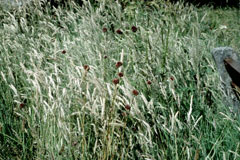 |
|
(c) 2010 Ken Fern, Plants For A Future |
 |
| (c) 2010 Ken Fern, Plants For A Future |
Translate this page:
Summary
A perennial, bulb-forming species wild onions, native to Europe, northwestern Africa and the Middle East. All parts of the plant have a strong garlic odour. The underground bulb is 1-2 cm diameter. Other Common Names: English: field garlic; wild garlic; wild onion. Spanish: ajito de las vinas; ajo cimarron. French: ail des vignes. Portuguese: alho-das-vinhas. Germany: Weinberg- Lauch. Italy: aglio delle vigne. Netherlands: kraailook. Sweden: sandloek.
Physical Characteristics

 Allium_vineale is a BULB growing to 0.6 m (2ft) by 0.1 m (0ft 4in) at a medium rate.
Allium_vineale is a BULB growing to 0.6 m (2ft) by 0.1 m (0ft 4in) at a medium rate.
See above for USDA hardiness. It is hardy to UK zone 5 and is not frost tender. It is in leaf from October to August, in flower from June to July, and the seeds ripen from August to September. The species is hermaphrodite (has both male and female organs) and is pollinated by Insects. The plant is self-fertile.
Suitable for: light (sandy) and medium (loamy) soils. Suitable pH: mildly acid, neutral and basic (mildly alkaline) soils. It cannot grow in the shade. It prefers dry or moist soil.
UK Hardiness Map
US Hardiness Map
Synonyms
Plant Habitats
Edible Uses
Leaves - raw or cooked[5, 177]. Rather stringy, they are used as a garlic substitute[2, 12, K]. The leaves are available from late autumn until the following summer, when used sparingly they make a nice addition to the salad bowl[8, 183, K]. Bulb - used as a flavouring[105, 161, 177]. Rather small, with a very strong flavour and odour[183]. The bulbs are 10 - 20mm in diameter[200]. Bulbils - raw or cooked. Rather small and fiddly, they have a strong garlic-like flavour[K].
References More on Edible Uses
Medicinal Uses
Plants For A Future can not take any responsibility for any adverse effects from the use of plants. Always seek advice from a professional before using a plant medicinally.
The whole plant is antiasthmatic, blood purifier, carminative, cathartic, diuretic, expectorant, hypotensive, stimulant and vasodilator[20, 257]. A tincture is used to prevent worms and colic in children, and also as a remedy for croup[257]. The raw root can be eaten to reduce blood pressure and also to ease shortness of breath[257]. Although no other specific mention of medicinal uses has been seen for this species, members of this genus are in general very healthy additions to the diet. They contain sulphur compounds (which give them their onion flavour) and when added to the diet on a regular basis they help reduce blood cholesterol levels, act as a tonic to the digestive system and also tonify the circulatory system[K].
References More on Medicinal Uses
The Bookshop: Edible Plant Books
Our Latest books on Perennial Plants For Food Forests and Permaculture Gardens in paperback or digital formats.

Edible Tropical Plants
Food Forest Plants for Hotter Conditions: 250+ Plants For Tropical Food Forests & Permaculture Gardens.
More

Edible Temperate Plants
Plants for Your Food Forest: 500 Plants for Temperate Food Forests & Permaculture Gardens.
More

More Books
PFAF have eight books available in paperback and digital formats. Browse the shop for more information.
Shop Now
Other Uses
The juice of the plant is used as a moth repellent. The whole plant is said to repel insects and moles[20]. The juice of the plant can be rubbed on exposed parts of the body to repel biting insects, scorpions etc[257].
Special Uses
References More on Other Uses
Cultivation details
Prefers a sunny position in a light well-drained soil[1]. The bulbs should be planted fairly deeply[1]. Grows well with most plants, especially roses, carrots, beet and chamomile, but it inhibits the growth of legumes[18, 20, 54]. This plant is a bad companion for alfalfa, each species negatively affecting the other[201]. This species is a pernicious weed of grassland in Britain[1], spreading freely by means of its bulbils[203]. Members of this genus are rarely if ever troubled by browsing deer[233].
References Carbon Farming Information and Carbon Sequestration Information
Temperature Converter
Type a value in the Celsius field to convert the value to Fahrenheit:
Fahrenheit:
The PFAF Bookshop
Plants For A Future have a number of books available in paperback and digital form. Book titles include Edible Plants, Edible Perennials, Edible Trees,Edible Shrubs, Woodland Gardening, and Temperate Food Forest Plants. Our new book is Food Forest Plants For Hotter Conditions (Tropical and Sub-Tropical).
Shop Now
Plant Propagation
Plants do not need any encouragement, they are more than capable of propagating themselves. Bulbils are produced in abundance in the summer and are the main means by which the plant spreads.
Other Names
If available other names are mentioned here
Native Range
TEMPERATE ASIA: Lebanon, Syria, Turkey, Armenia, Azerbaijan EUROPE: Denmark, Finland, United Kingdom, Ireland, Norway, Sweden, Czechoslovakia, Austria, Belgium, Switzerland, Germany, Hungary, Netherlands, Poland, Ukraine (incl. Krym), Former Yugoslavia, Albania, Bulgaria, Greece, Italy, Romania, Spain, France, Portugal AFRICA: Spain (Canarias), Algeria, Morocco
Weed Potential
Right plant wrong place. We are currently updating this section.
Please note that a plant may be invasive in one area but may not in your area so it’s worth checking.
Possibly a noxious weed in parts of Australia, North America (esp. Arkansas, California, Hawaii), and Kenya.
Conservation Status
IUCN Red List of Threatened Plants Status : This taxon has not yet been assessed.

Growth: S = slow M = medium F = fast. Soil: L = light (sandy) M = medium H = heavy (clay). pH: A = acid N = neutral B = basic (alkaline). Shade: F = full shade S = semi-shade N = no shade. Moisture: D = dry M = Moist We = wet Wa = water.
Expert comment
Author
L.
Botanical References
17200
Links / References
For a list of references used on this page please go here
Readers comment